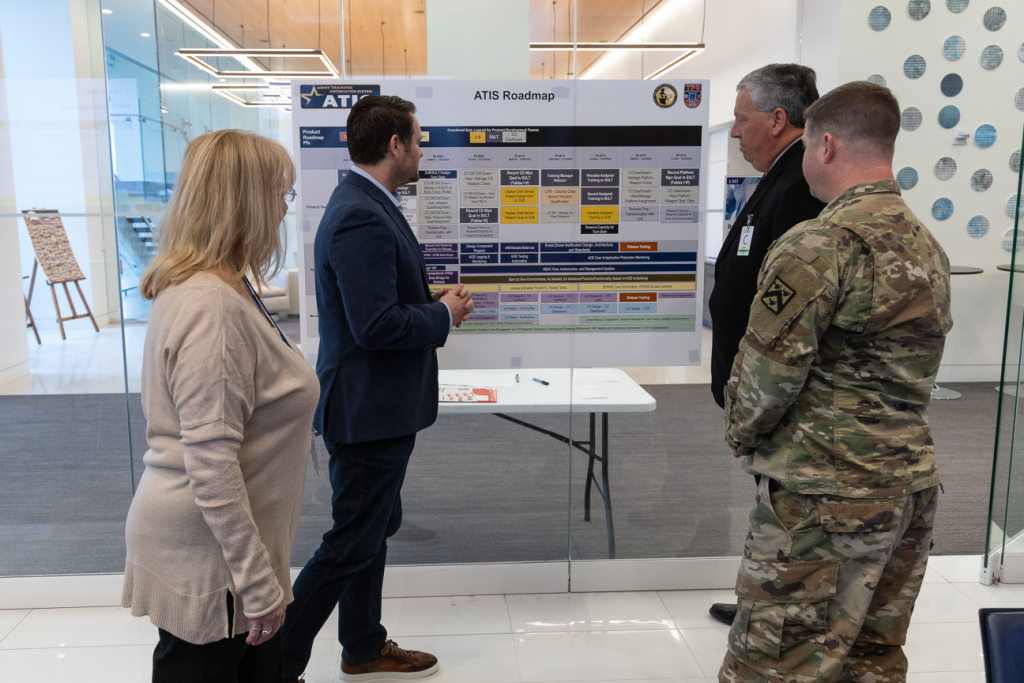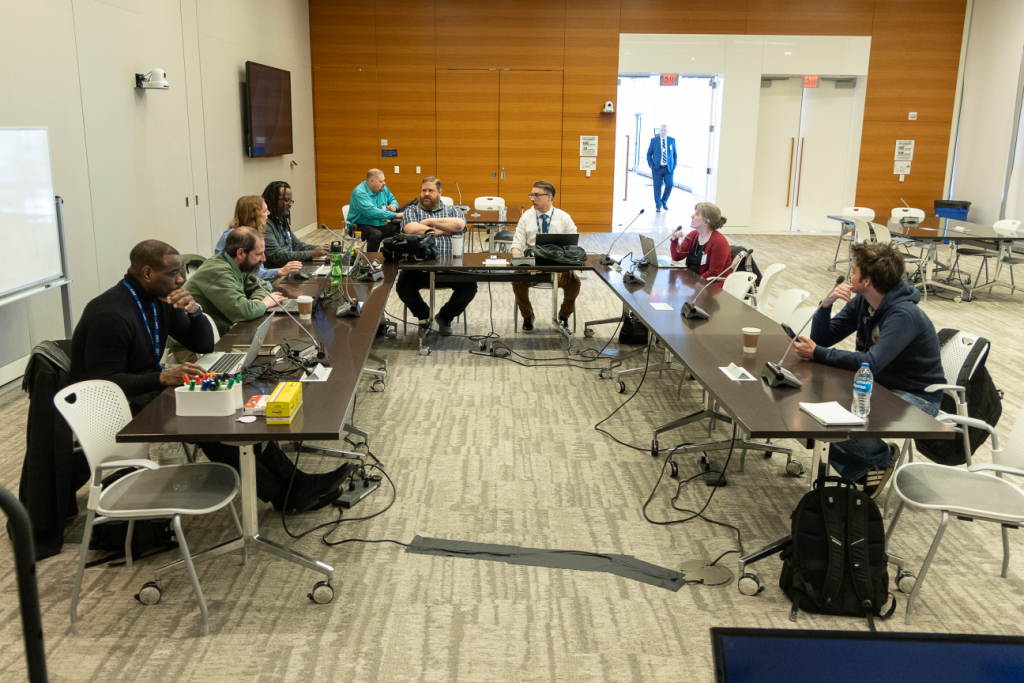
DRAFT OBJECTIVES: Product Team One hosts a team breakout session at the program increment planning event where the team’s cross-domain experts and government product owner draft and prioritize their objectives for the next 10 weeks of development. (Photos by Dave MacLuskie, Product Manager ATIS)
PEO EIS uses Agile methodologies and a diverse set of teams to develop wide-ranging ATIS program.
by Maj. James Oliver
The U.S. Army has one of the world’s most distinctive and varied populations, comprised of Soldier and civilian communities with varied specialties, backgrounds and demographics. They must continually adapt to evolving tactics, technology and doctrine—factors crucial to maintaining the Army’s competitive edge. This dynamic setting aligns well with the use of Agile methodologies, as iterative processes and incremental delivery of capability provide opportunities for Army acquisition programs to solicit continuous feedback and refine their approach.
Agile methodologies are particularly essential in complex software development programs, where the malleability of code and the highly competitive nature within the information technology (IT) industry make change especially frequent.
Recognizing the importance of adaptability, the Army Training Information System (ATIS) product office under the Program Executive Office for Enterprise Information Systems (PEO EIS) adopted the Scaled Agile Framework (SAFe) and instituted parallel user-centered iterative processes aimed at delivering best value for ATIS’ exceptionally unique and diverse user population. The program has undergone a significant evolution since the launch of its first Agile Release Train (ART), with substantial refinement of its processes putting increased emphasis on continuous community and user feedback to best shape and deliver an ideal solution for Soldiers.
AN APPROACH BUILT ON COLLABORATION
ATIS is tasked with delivering a cutting-edge, one-stop training management, development, scheduling, resourcing and distributed learning system for the Army. It will replace 28 legacy systems and more than 70 applications with one authoritative system, and will have a user population including all Soldiers, Army government civilians, military in other DOD components, and many others, including contractors and foreign allies. This makes ATIS a complex solution for a complex problem, requiring continuous input and buy-in from all of the system’s user communities to ensure the build of ATIS can benefit from the extensive lessons learned and feedback the legacy systems have gathered over years of operation.
To facilitate this collaborative relationship, the program established an iterative backlog refinement process centered around two recurring events—epic and feature development, and epic and feature refinement—that bring together legacy system experts, representatives from the Combined Arms Center – Training (CAC-T), and ATIS requirements analysts and user experience researchers.
The epic and feature development event happens once per 10-week interval, with the primary goal of informing and framing features for the program’s backlog, essentially breaking down the plan for delivering ATIS’ complex, objective solution into smaller, more manageable Agile work items that can be delivered incrementally by the program’s cross-functional teams. At these events, legacy system experts provide live demonstrations of their systems and discuss friction points and opportunities for improvement on what value those legacy systems deliver for their user communities. These insights are incredibly valuable in framing the future build of ATIS, as they uncover potential pitfalls, challenges, risks and opportunities for greater user satisfaction. By capturing these insights, ATIS ensures that the features written for the program backlog are best informed from the very beginning of the process.
The epic and feature refinement event takes place every week and brings together stakeholders from all of the program’s user communities. They collaboratively outline acceptance criteria, annotate traceability to functional requirements, identify possible interfaces and dependencies and further refine the scope of individual features. All these details are logged in GitLab, the program’s collaborative project management platform and version-controlled repository, during the live meeting to ensure that nothing is overlooked and that the process is open and transparent. While the development events may eventually end as all requirements are initially framed into features, the refinement events will continue throughout the program life cycle.
ATIS’ iterative backlog refinement process fosters a culture of continuous improvement, maximizes collaboration and reasserts the Army training community’s steadfast commitment to delivering optimal value for Soldiers. It provides ATIS with opportunities to learn from past mistakes and incorporate lessons learned, honing its approach to crafting an ideal and relevant solution for the Army. Ultimately, the process provides teams with a well-informed starting point as they prepare to build and deliver features outlined in the program’s backlog.

ON THE MAP: Melissa Lee and John Tato, left, brief U.S. Army Training and Doctrine Command ATIS Proponent Office leaders Col. Kevin Riley and Dave Bolt on the program’s road map during the program increment planning event in March 2024.
BUILDING THE RIGHT TEAMS
In September 2022, ATIS launched its first Agile Release Train (ART). The ART is ATIS’ “team of teams,” consisting of cross-functional teams that collaborate to deliver the objective solution. The ART plays a pivotal role in keeping the teams aligned to the same program vision, cadence of work and consistent iterative processes. It also manages cross-team dependencies and knowledge sharing, reducing risk and promoting efficiency. While the ART provides a powerful modular framework, offering the program a high degree of flexibility while ensuring an adequate level of predictability, the real work is done at the lowest level by the cross-functional teams.
The teams on ATIS’ ART include both product teams and enabling teams. The multidisciplinary product teams are building the ATIS objective application, using a range of diverse perspectives and expertise to encourage innovation, effective communication and maximum agility in iteratively defining, building, testing and deploying software. The enabling teams, on the other hand, define and convey the architectural vision, oversee DevOps alignment, lead system interface work, oversee seamless integration of the solution and enable the work of the product teams in every aspect.
The mix of responsibilities and relative autonomy of the teams require a diverse range of expertise. Although every position and role on each team is crucial for the success of ATIS, there are three roles that ensure Soldiers have a voice in every facet of ATIS design and development: the government product owner, the user experience (UX) researcher and the UX designer. These roles provide the Army with three substantial reasons to be confident ATIS will deliver relevant and best value.
THE ROLE OF THE GOVERNMENT PRODUCT OWNER
ATIS benefits tremendously from the decentralized team of teams approach prescribed by the Scaled Agile Framework, which provides teams with significant autonomy during their iterations, allowing them maximum flexibility in systematically constructing ATIS one piece at a time. To optimize efficiency—while simultaneously ensuring collaboration, oversight and that user communities have a voice at the team level—ATIS has embedded government product owners on every team.
These team members act as the voice of the Army at the team level. They set the priorities for their teams at the beginning of each 10-week interval, receive demonstrations of the work being delivered at the end of each two-week sprint. At the end of each 10-week interval, they make the determination as to whether the work delivered realizes the business value planned.
ATIS has filled these crucial positions with government civilians and military personnel from the Combined Arms Center and the Army Training and Doctrine Command. They’re the individuals most familiar with the capabilities of the legacy systems ATIS is subsuming, and have the most holistic understanding of the requirements. Their embedded role on teams expedites decision-making by enabling them to provide on-the-spot feedback and guidance. This dynamic also provides the teams with a level of autonomy, accelerating team velocity and decreasing the time it takes the contractor to deliver capability to the Army. Additionally, this approach minimizes the risk of miscommunication and potential rework, ultimately contributing to long-term cost avoidance for the program.

PROGRESS REPORT: The ATIS system team hosts a team breakout session at the program increment planning event. At the end of each 10-week interval, program participants decide whether the work they’ve delivered advances development.
A USER-CENTERED DESIGN PROCESS
The second and third roles bringing the voice of Soldiers to ATIS are the UX researcher and UX designer. The researchers on the ART’s product management team are closely aligned to the requirements analysts, who work hand in hand to ensure the end user’s voice is heard and incorporated in the write-up of features.
The UX designers are embedded on every product team, closely aligning them with the developers who will be implementing the design. This streamlines communication and ensures end-user needs are well communicated and understood by the developers before they begin writing or integrating code, dramatically reducing the risk that ATIS won’t deliver a relevant solution for Soldiers. Ultimately, the strategic placement of the UX researchers and designers within teams is designed to support the program’s end-to-end, user-centered approach to UX design, which requires that they’re able to empathize and communicate the needs and preferences of end users during every step of ATIS’ design and development cycle.
CONTINUOUS USER ENGAGEMENT
In December 2022, Headquarters Department of the Army tasked Army commands and direct reporting units to provide users for ATIS’ user engagement process. The order required Soldiers and government civilians to participate in user engagement sessions with ATIS’ UX researchers, providing them with sufficient opportunities to understand user needs, generate design ideas and validate or invalidate ideas through continuous user engagement. This process ensured the program would make design decisions backed by empirical data generated through continuous engagement with Soldiers and government civilians, further ensuring that ATIS will deliver an ideal and relevant solution.
As of March 2024, ATIS’ UX researchers have engaged with more than 170 Soldiers and government civilians in live video sessions where users are asked to provide input on ATIS’ upcoming work. During those sessions, system end users describe their preferences and any unofficial workarounds they’ve created to overcome the challenges of using legacy IT systems. Those engagements inform the building of design prototypes, which end users provide additional feedback on, validating the efficacy of UX design before it’s handed off to developers to implement.
CONCLUSION
The Army’s collective shift toward Agile is providing an opportunity for acquisition programs to take a more collaborative and user-centered approach, a paradigm exemplified by ATIS. The iterative nature of Agile supports recurring events and feedback cycles, providing government community representatives with opportunities to continuously provide input—the value of which can’t be overstated as they’re experts with years of experience in engaging with their unique populations.
Furthermore, Agile teams deliver software incrementally, providing embedded government product owners with the ability to iteratively direct and verify that what’s being delivered is the best value for the Army, and the UX design of the software can be backed by empirical data iteratively solicited and validated by system end users before code is ever written and implemented. This shift to an Agile approach is being accompanied by a shift in culture, in which a user-centered mindset is paramount in delivering best value. If embraced, Army acquisition programs could perpetually field solutions that Soldiers want to use.
For more information on ATIS, go to https://www.pdmatis.army.mil/Media-Resources.html.
MAJ. JAMES OLIVER is the assistant product manager for the ATIS, in Newport News, Virginia. He began his military service as an infantryman in the Indiana National Guard in 2007. Since commissioning into the Army in 2012, he’s served with the infantry, the Adjutant General Corps and now the Army Acquisition Corps. He holds an M.A. in human resources management from Webster University, an M.S. in systems engineering management and a certificate in advanced acquisitions from the Naval Postgraduate School He holds a B.A. in history from Ball State University. His professional certifications include Project Management Professional, Associate Systems Engineering Professional and SAFe 6 Practice Consultant.







